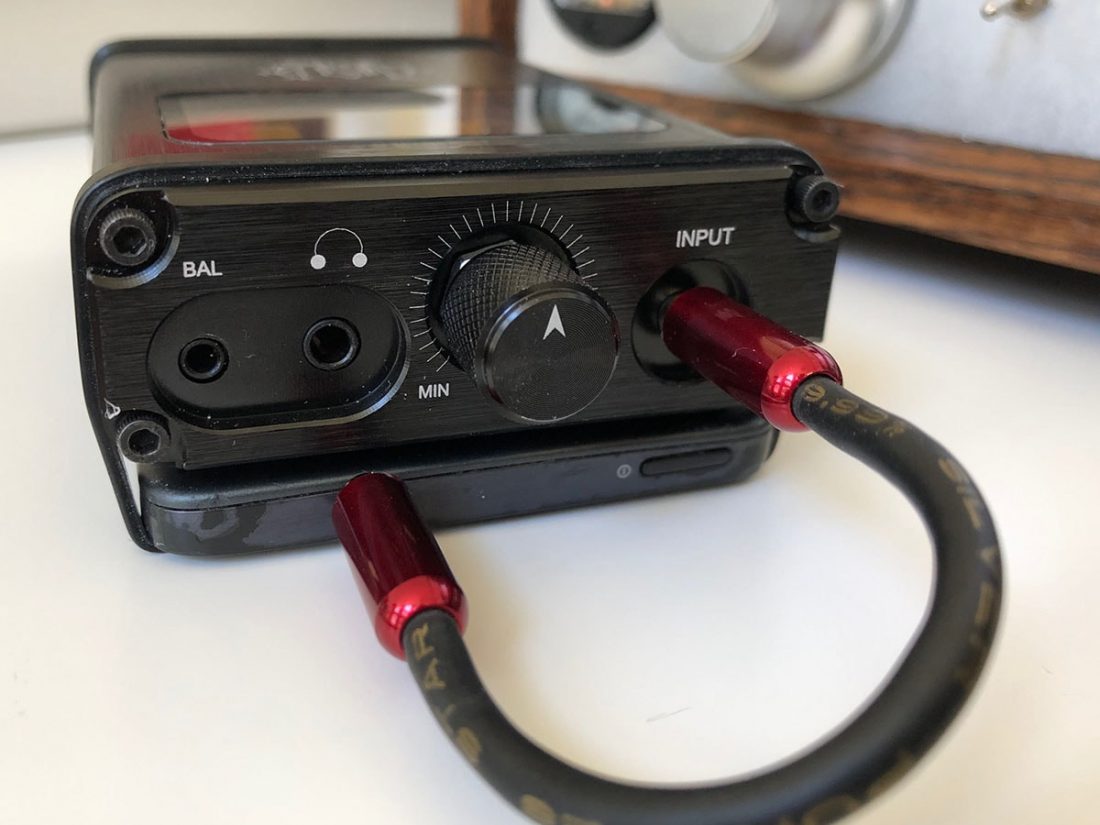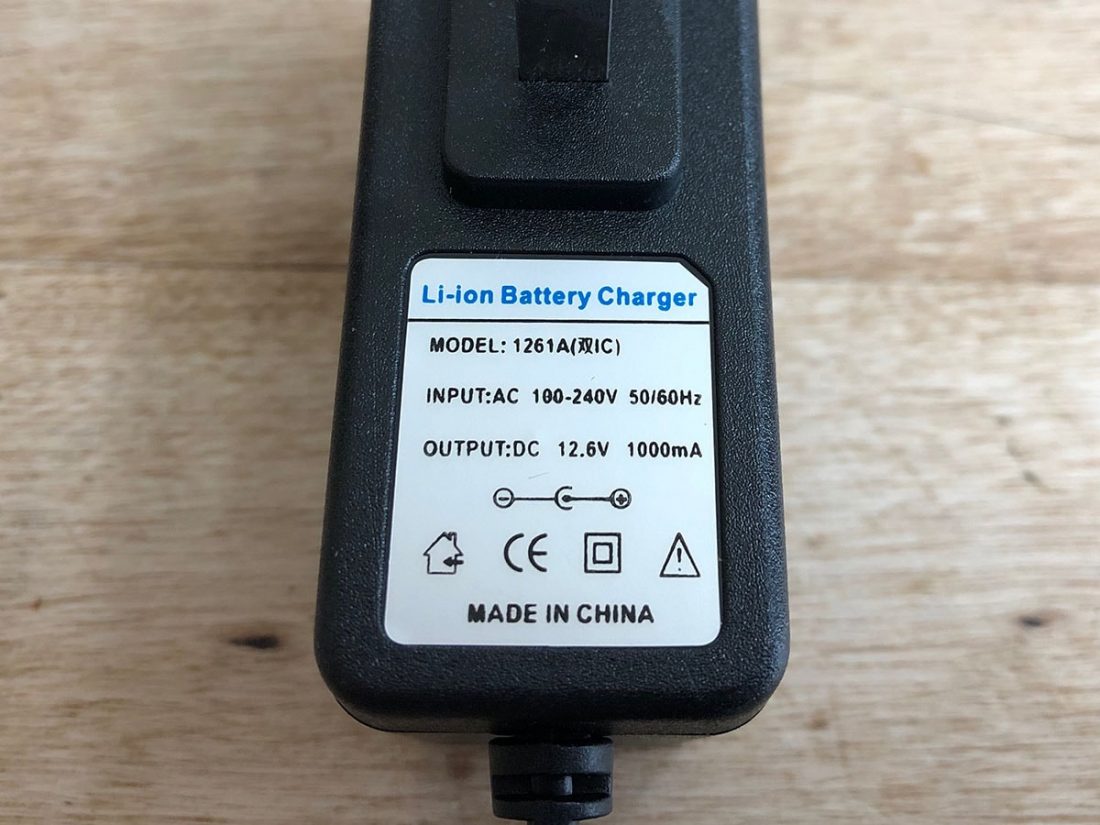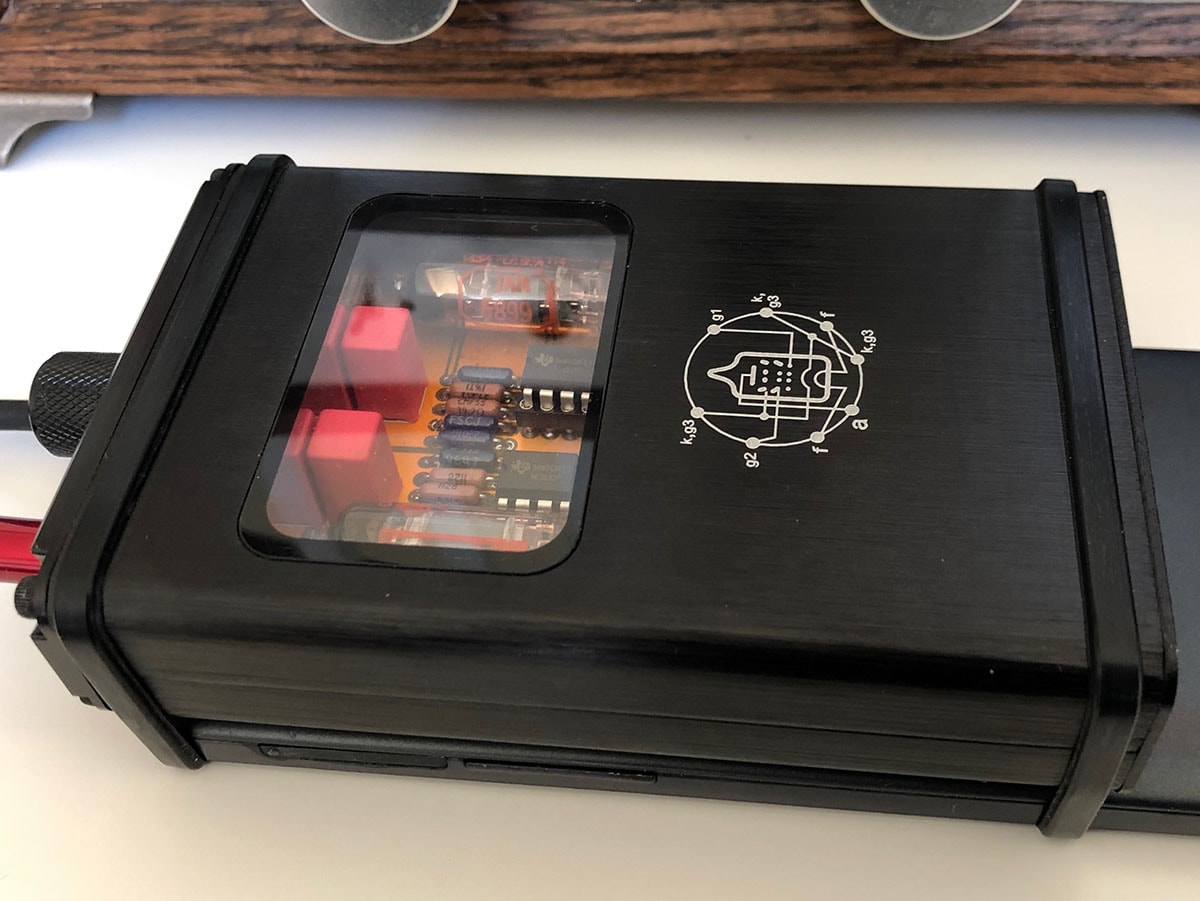A Curiosity full of Tubes and Compromises
Douk Audio (also known as Nobsound), a subsidiary of Shenzhen Cavins Technology Co., Ltd., was founded in 2013 in Shenzhen China. The company motto is to “make Hi-Fi affordable” by following the rules of (in their words) “quality-oriented, customer-centered and constant innovation”. They produce a wide range of stereo amplifiers, headphone amplifiers, DACs, phono stages and preamps, with an emphasis on vacuum tube components.
The product lineup is a super-interesting array of unique audio doohickeys and gadgets, and it exemplifies a fascinating side of Chi-Fi. High tech components with eye-catching features at puzzlingly low prices. Devices that would likely never get manufactured anywhere else. Today we will be looking at a perfect example of this phenomenon, the Little Bear B4-X.
So, what makes the B4-X portable headphone amplifier so interesting?
- Socketed OpAmps to allow for OpAmp rolling? Check.
- Vacuum tube hybrid design? Check.
- Balanced and unbalanced outputs? Check.
All for around a $100 USD! How is that even possible?
- It’s a portable tube amp. How cool is that?
- Quality parts list: Nichicon and Wima electrolytic capacitors and Dale resistors.
- Socketed OpAmps allows for easy OpAmp rolling.
- Surprisingly high-quality 3.5mm to 3.5mm input cable.
- Balanced and unbalanced outputs.
- Audible interference from nearby cell phones.
- The front window fell out with minimal use.
- Unlabelled and unprofessional tape-covered package.
- Occasionally temperamental sockets causes channel cut-outs and imbalances.
- Little difference between balanced and unbalanced outputs.
- Dual is misspelled “Daul” on both the board and the case.
Douk Audio’s Other Portable Tube Amplifiers
The B4-X isn’t the only portable tube headphone amplifier option currently available from Douk Audio. The B4-X is the most expensive though, at about a 40% premium over the basic B4. The differences between the B4 and the B4-X include:
- Douk Audio states that the B4-X is a dual-mono balanced device. Unlike the B4, its left and right channels are amplified by independent components. Power supply, tubes, and OpAmp chips are all independent and duplicated. They claim that this increases the degree of sound separation between channels when compared to the B4.
- Douk Audio rates the B4-X adequate to drive 300Ω headphones, while they rate the B4 only for up to 200Ω headphones.
- There is a separate power switch on the B4-X rather than having the on/off integrated into the volume pot as with the B4.

Douk Audio also offers the B5 portable tube headphone amplifier. While the B4 and B4-X share the same physical casing, the B5 is slimmer and lighter. It’s also only $60 (rather than $75 for the B4 and $105 for the B4X). Battery life and durability are also reportedly improved. However, it is only rated for 100Ω headphones and is supposedly more subject to microphonics and noise. The OpAmp chip is non-replaceable in the B5 model.
Little Bear B4-X Technical Specifications
- Tube: USA miniature RAYTHEON JAN5899 *2
- OpAmp: NE5532 *2 (can be upgraded)
- Lithium battery: 12V, 1000mA
- Charging time: 2-2.5 hours
- Working time: 4-4.5 hours
- Output power: 450 mW
- SNR: 105 dB
- Suggested load impedance: 16-300Ω
- Output: 2.5 mm balanced Jack *1, 3.5 mm Jack *1
- Size (L*W*D): 115*69*23 mm / 4.5*2.7*0.9 in (without knob)

Packaging and Accessories

In a plain, unlabelled and unimpressive cardboard box, you will find the following:
- B4-X headphone amplifier.
- 12.6V 1000mA wall-wart style power supply.
- Double ended 3.5mm TRS 140mm audio input cable.
- 2 rubber bands to tether the B4-X to a portable source.
- Instruction manual.

Design and Build Quality
The quality of the B4-X is a bit of a mixed bag. Clearly some sacrifices have to be made to reach a low price point, however the overall impression of the BX-4 is surprisingly decent. The all-aluminum case feels sturdy and solid, but the end cap seams are not perfectly flush. This, plus spelling mistakes, plus the textured finish, just doesn’t add up to a premium product.

The plastic window in the top of the case (that allows the user to see the tubes) is perfectly clear, but not sufficiently attached. After a couple listening sessions my window simply fell out of the case. Gorilla glue to the rescue. It also seems to scratch quite easily, so caution is advised if carrying the B4-X around in a pocket.
I found the sockets to be somewhat temperamental. Occasional channel imbalances could be fixed by rotating a plug or by unplugging and replugging cables into sockets. Rather annoying to be honest.
The dropouts and imbalances didn’t happened every time I used the B4-X, but it did occur with a variety of sources, cables and headphones. I couldn’t quite track down the primary source of the issue, although it appeared to happen more when driven from the iFi iDSD Nano and seldom when using a phone as a source with the included cable. This leads me to believe it may have been a grounding issue with the iFi/Macbook source combo.
The knurled aluminum knob feels high quality and the volume pot rotates with minimal channel imbalance and a pleasantly smooth resistance. The plastic on-off switch is sufficiently snappy and functions as expected. All printing on the case is crisp and clean.
The included rubber bands (intended to tether the B4-X to a portable source) are thin and has a cheaper feeling than the JDS Labs versions I’m used to, but they worked just fine. The thin band profile is actually somewhat beneficial as it covers less of the phone screen when tethered together with the B4-X.

Cable
A very welcome surprise included in the package is the remarkably nice, 140mm long, dual 3.5 mm TRS cable. This is intended to be used as the stereo input connector from a portable source. Labeled “99.99% Silver Pure 28 Star…” it is impeccably terminated in red metal plugs, is supple and agreeably flexible, and really feels great. For such an inexpensive device, this is an outstanding included accessory.

Charger
The external 12.6V, 1000mA li-ion battery charger is of inexpensive and generic design. Nonetheless, the indicator LED (on the back of the charger) does change from red (charging) to green (charged) and functions as expected. The LED will turn yellow if there is an issue.
The charging estimates are of 2-2.5 hours with a 4-4.5 hour run time. While this is not exceptionally generous, it is about what I experienced with use. Unfortunately, the B4-X does not support USB charging, so the charger must be packed for longer trips.

Internal Components
The quality of the circuitry is one of the main advertised features of the B4-X. Well-respected, brand-name Nichicon and Wima capacitors and Dale resistors are visible through the front window. The ‘made-in-USA’ Raytheon JAN5899 tubes are soldered to the board (so alas, no easy tube rolling for you adventurous DIY folks).
The OpAmps are socketed and do allow for easy replacement. Douk Audio is surprisingly open about responding to rolling (substitution) questions; something many manufacturers leave solely to the owner.

OpAmp Rolling Options for the B4-X
Douk Audio’s OpAmp recommendations (note that the approximate price listed is for 1 OpAmp and the B4-X requires 2):
| Sound Signature | OpAmp | Price (for 1) | Supplier |
|---|---|---|---|
| Stock | NE5532 | $1.04 | Digikey.com |
| Upgraded | OPA2604 | $4.30 | Digikey.com |
| Vocals | DY649 | $9.11 | Chinahao.com |
| Analytical | AD712 | $11.14 | Mouser.com |
| Comprehensive | OPA627 | $37.27 | Digikey.com |
| Boutique | V5, V5i and V6 SS3602 | $48, $39, $70 $80 | Bursonaudio.com Sparkoslabs.com |
The full list of compatible OpAmps should likely include:
AD823, AD823AN, AD8066, AD8620, AD712, AD827, BA15532, C4570, JRC4556AD, JRC4558, JRC4580, JRC5532, JRC5532D, JRC5534, LF353, LM4562, LM833N, LME49860, MUSES01, MUSES02, MUSES8820, MUSES8832, MUSES8920, NE5532, NEC4520, NEC4570, NJM2068D, NJM2114, NJM2214D, NJM4558, NJM4558D, NJM4558P, NJM4560, NJM5532, OP275, OPA1612, OPA2132, OPA2134, OPA2277PA, OPA2604, RC4558D, RC4558P, TL052, TL072

Sound Quality
To be honest, I wasn’t blown away by the B4-X upon first listen. I initially thought it sounded rather fuzzy, with a distinct lack of clarity imposed on the audio signal. Yes, yes… solid-state amp fans, I hear you… it IS a tube amp… I know! Tubes do add distortion, but a well implemented tube amp isn’t supposed to degrade the signal, it’s supposed to add pleasant (second order) harmonics. A bit of body added to the sound, making it fuller, with none of the good stuff removed.

Over time, things improved. A lot. The more I used the B4-X, the more I liked the sound. One or both of us went through a break-in period. Perhaps the tubes settled in and improved. Perhaps I simply adjusted to the sound. Either way, the B4-X grew on me.
I swear the clarity has improved dramatically. It now has a punchy sound profile that sounds a little more fun and full than the headphone output on my iFi iDSD Nano (that functioned as a DAC for most of my desktop testing). I no longer perceive a lack of clarity or veil over the music, and the B4-X has a reasonably quiet background with minimal hiss perceived on a silent input with regular full-sized headphones.
In contrast, when paired with efficient IEMs, such as the KZ ZS10 Pro (24 Ohm, 111 dB), there is a pervasive audible hiss and static that is constant regardless of volume level. Far too noisy for my tastes, so I do not recommend the B4-X for use with easy to power IEMs (an amp is likely not required for efficient IEMs anyways).
Headphone Pairings
It would be nice to know the output impedance of the B4-X in order to make educated assumptions regarding proper headphone pairings. Douk Audio claims that the B4-X supports 16-300 Ohm headphones, so I tested it with a wide variety of headphones on hand.

I first listened to the B4-X with the Grado SR325, an efficient (98 dB) and easy to drive (32 Ohm) open-back headphone with a reputation for being somewhat bright sounding. Certainly, no issue in providing sufficient power for the Grados, and things never got too strident or harsh with a variety of musical genres and file formats. A fine audio pairing and the DIY-retro-cool aesthetic of both products is complimentary.
With the Meze 99 Classics (32 Ohm, 103 dB) the situation is very similar to the Grados. With this excellent sounding, slightly bass-heavy, closed-back model, the B4-X offers plenty of power and works well.
Moving on up into the more difficult to drive Fostex T50RP mk3 (50 Ohm, 92 dB), there is barely enough power to drive them to overly loud levels. Half volume is fairly quiet, with ⅔ yielding normal listening levels. Full volume is tolerable but too loud for my tastes. It is however, relatively free from distortion.
The Sennheiser HD58X is a 150 Ohm, 104 dB open-back headphone. I own both balanced and unbalanced cables for this headphone and for its older brother the HD650 (300 Ohm, 103 dB). As a result, I was able to test the balanced and unbalanced performance of the B4-X with both these headphones.
Balanced vs Unbalanced Headphone Connections
The HD58X seems slightly easier to drive than the Fostex T50RP mk3. Again, between ½ volume and ⅔ volume yielded a normal listening level for me. Full volume is again too loud for my tolerance, but it remained relatively clear.

The HD650 is noticeably quieter at the same volume level as the HD58X (¾ volume for my normal listening level). The B4-X is just barely powerful enough to drive these 300 Ohm headphones. I can imagine someone who prefers a louder listening level finding that the B4-X doesn’t quite have enough power to suffice.
So enough of all that volume info. Let’s get to the question of the day. How much better is the balanced output?
If you (like me) were expecting increased volume due to the inherent power increase in a balanced connection over unbalanced, you will be disappointed. There is little to no discernable difference between the connections. It’s not significantly louder, nor does the balanced output appear to yield any sonic improvements. If it does, it’s too subtle for my ears.
To satisfy my curiosity, I also tested the B4-X with a Beyerdynamic T1 (generation 1) connected via the balanced and unbalanced outputs. These 600 Ohm, 104 dB headphones are clearly far beyond the recommended 300 Ohms supported by the B4-X. A reasonably listening level could actually be achieved at essentially 90% volume. The T1 sounded remarkably pleasant powered this way. Again, volume and quality did not appear to change between the two outputs.
Conclusion
Let’s be clear, the Douk Audio B4-X is kind of a novelty. It’s a bit of a toy. Heck, it’s a $100 tube amp that you can put in your pocket and use to warm up your hands. However, that does not mean that it doesn’t do the job.
The B4-X actually sounds quite good. Surprisingly good, to be frank. It adds a full and fun sound signature lacking from a purely solid-state source. And shouldn’t good sound be the most important consideration when considering a music playback device?

You must remember that the low price point comes with a number of compromises. The build quality of the window and the sockets is suspect. Unfortunately, battery and charging issues are reported on Amazon. Longevity is certainly an open question.
While the B4-X is clearly designed to be a portable device, it does have a few serious drawbacks in that department:
- It picks up nearby cell phone wireless noise and interference. Using the SPMC app on Android (with the phone tethered to the B4-X) the interference audibly changes in response to the loading bars on the screen. This is mostly only noticeable when listening with efficient IEMs, but is far from ideal.
- On the topic of efficient IEMs, the circuit noise is intolerable.
- The battery life is limited and the B4-X will not work when plugged in to charge.
- Like any tube amp, the tubes ring (make a pinging noise through the headphones) when the “portable” device is moved or bumped.
For the B4-X, the balanced output is more of a feature gimmick than a real sound quality improvement. I’m not really surprised at this price point, but it does make me wonder if the Douk Audio B4 might be the better value. The B4 has no balanced output, but it costs almost 40% less and only requires the purchase of a single OpAmp to try rolling. What’s better for you likely depends on how difficult your headphones are to drive.
In the end, I don’t regret my purchase. For sound quality, the B4-X actually exceeded my expectations, but in most other ways, it simply gave me what I expected. I expected compromises, and sure enough, the Little Bear B4-X delivered.


I wish it had a 2.5mm input… Do you know of any headphone amp that has 2.5mm balanced input and output?
iFi xCan has both 2.5mm input and output.
Btw, channel imbalance is very normal for tube amp. Gain and voltage per channel can be easily adjusted on the board with a screwdriver to remove imbalances.